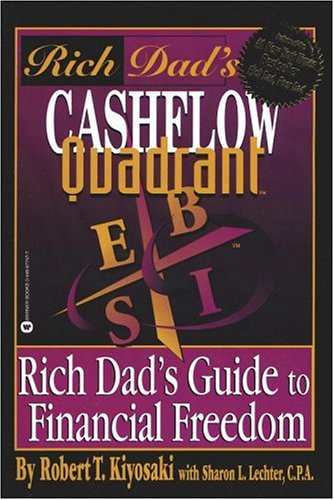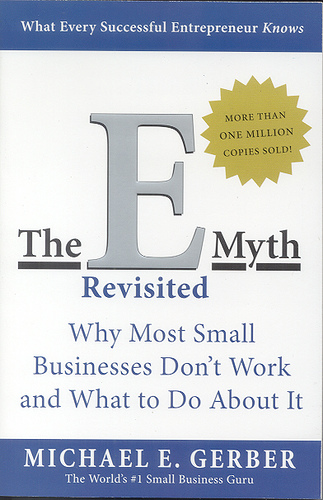Must Have “Guide Books” for Running a Business

I used to own a business.
At least, that’s what I thought . . . until I read Robert Kiyosaki’s Cashflow Quadrant.

- They can’t walk out the door at 5pm (or, more likely, 10pm–or any other time) and forget about work;
- They can’t take an extended vacation. Forget it. No “long service leave” or “sabbatical” for them!
- And — have you ever noticed — the self-employed don’t seem to get sick nearly as often as employees.
The Solution? Getting Ordinary People to do Extraordinary Things
Wander along Main Street or through any shopping mall and keep your eyes peeled.
You can tell, just by looking, the difference between the shops that are one-man or -woman shows, and those that fit Kiyosaki’s definition of a business. Here’s a clue:
Some of the shops are run by kids, with nary an adult in sight. They’re all unskilled labor.
Which stores? Usually the Starbucks, McDonalds, Kentucky Fried Chicken, and other chains or franchises. These businesses take people off the street and within a few days they’re flipping hamburgers and making cappuccinos indistinguishable from the experts.
How?
With a manual. Usually a thick binder that’s handed to every new hire. In that manual is every step–in excruciating detail–an employee needs to take to produce that hamburger or latteperfectly. Every time!
Manuals are the end product of a Business System, specifying everything the employee needs to do or know; they make it possible for ordinary people to do extraordinary things.
When every function your business must perform is in a manual, you’ll be able to hire some of those kids yourself to run your business like clockwork.
And take that round-the-world cruise you (or, perhaps more likely, your spouse) have been dreaming about.
Just Do It? . . .
Consider two ways of starting a business.
The first I call the Just Do It! Approach. My own story is typical.
When–years ago–I started my investment newsletter, I did everything. Licked the stamps, went to the post office, wrote and booked the ads, analyzed the markets and wrote all the content–even laid out each issue so it was ready to print.
The only thing I didn’t do was print it (but I did collate and fold the issues, and stuff them in envelopes).
As it became more successful, I added employees to the routine work.
It looked like a business–even “smelt” like a business. There was an office full of busy people; an incorporated company; customers in 119 countries; audited accounts . . . you name it, I had it.
Except for one thing: that round the world cruise.
Every word of every issue and every ad was usually written by me(and if not, edited by me); every non-routine decision landed on my desk.
As my business–ah, my “job”–became more successful, more and more things piled up on my desk. There was a bottleneck in my business that would always keep it small: Me!
. . . or: take the Franchise Approach
The second way is the Franchise Approach.
Consider what comes with a business franchise:
- A complete, proven, “off the rack” business system, including those all-important manuals so you can hire kids off the street and “turn them into experts” in just a few days!
- A manual for your job: Manager. (You can even hire someone else to take that spot while you head for the beach.)
- Training in how to run the system.
No, I’m not suggesting you buy a franchise (though that’s always a possibility). I’m suggesting you start or recreate your business using the “Franchise Approach.”
Imagine you’re going to start a business you can franchise. That could be “cloned” thousands of times around the world.
A business that could, potentially, become a really big, S&P500 listed company.
To do that, you must first create the package you could sell to a potential franchisee: your Complete Business System.
Then you apply it.
Instead of “owning a job” you now “own a business.”
Installing “Clockwork” in Your Business
Here are two suggestions that will put you on the road to having your business running like clockwork:
- Go work for Starbucks, McDonald’s, Pizza Hut, or one of the other big franchised chains.
I’m serious! Reading books and going to lectures are great ways to learn. But nothing beats experience; that’s the best way to learnanything.
Work at Kentucky Fried or Taco Bell for just a few days and you’ll experience a Business System at the cutting edge: the very bottom. What’s more, you’ll get to see one of those all-important Manuals I’ve been talking about.
Seeing that Manual and experiencing how it works will make itmuch easier to create your own for your business.
Alternatively, pick the brains of people who work there and maybe you can persuade one of them to look at their Manual.
Except “Manual” sounds a bit dull, doesn’t it? Creating a successful business is a bit like baking a cake. First, you have to have all the ingredients at hand. Then you have to follow the recipe.
You can’t bake a cake–or create a true business–without them.
Creating Your “Recipe” Book
Getting a “feel” for how a Business System works is one thing; to create your own you need a “Guidebook” really helps. So . . .
- Get Michael Gerber’s The E-Myth Revisited: Why Most Small Businesses Don’t Work and What to Do about It.

Gerber spells out, chapter and verse, how to create a Business System that’s perfect for yourbusiness–and how to put it into effect.
- Some 50%+ of all new businesses fail in the first year. After five years, only 20% of those startups still live on.
- The first-year failure rate for the “Franchise Approach” is significantly lower: a miniscule 5%!
- And after five years? A whopping 75% of them are still coining money.
To put it another way, adopting the “Franchise Approach” multiplies the chances of your business success by almost 400%!
Isn’t it time, as Gerber puts it, to start working “on your business, not in it”?
[Ed. Note. Mark Tier–an Australian based in Hong Kong–founded the investment newsletter World Money Analyst, and is the author of The Winning Investment Habits of Warren Buffett & George Soros. His latest book is a political thriller titled Trust Your Enemies (“Politics, corruption blackmail, lies . . . and that’s just the first three pages!” . . . ). Learn more on Amazon.]